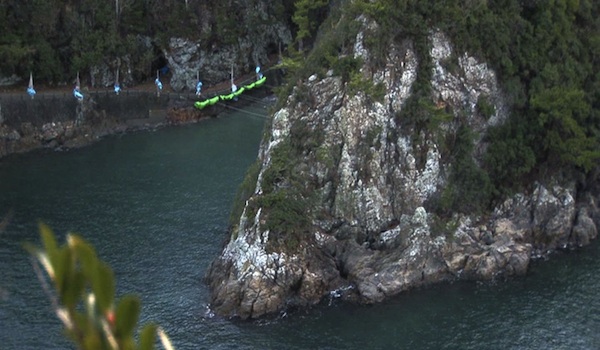The Cove
Posted on September 11, 2010 By John Gilpatrick 2000s, Documentaries, Movie Reviews

I’ve said before on this blog that I’ve never really been a huge fan of documentaries. To be fair, I don’t watch all that many (maybe three or four per year on average, although a quick survey of 2010’s slate of non-fiction tells me that number will be much higher). I think the reason I typically avoid them is that they are usually limited by what they can do. Some documentaries stir your intellect and make you think. Others make you feel something—joy, sorrow, anger, empathy, something else entirely, or some combination of these emotions. I didn’t think documentary films were capable of both true intellectual and strong emotional stimulation. That was before I saw The Cove.
This film, a true labor of love for its creators, is like a punch to the gut on both levels. It opens your eyes to a real atrocity, the mass dolphin killing in Japan (and the hypocrisy and cowardice of those in power who turn a blind eye to it). It also devastates you with its uncompromising approach to the material. It doesn’t hold anything back, and when you see the waters turning red, it’s just shocking and a bit overwhelming emotionally.
In Taiji, Japan, there is a cove. It’s inaccessible to anyone but local fishermen, but its purpose is known to many. In this cove, hundreds of dolphins are slaughtered each and every day. They are disoriented by the fishermen and trapped near the shore in nets. A lucky few are purchased by dolphin trainers for zoos or aquariums. The rest are shuffled off into the cove and disposed of.
The film follows a number of threads related to this horrific practice. The main storyline follows the filmmakers, including director Louie Psihoyos, as they try to capture video and audio footage of the actual killing. It’s clear in the interviews with those involved in this practice that they know what’s going on, but all they do is deny, deny, deny. Psihoyos and his team vow to get some actual evidence, so they employ the help of Industrial Light and Magic to create hidden cameras and audio devices that will do the trick.
Interspersed with the mission itself (which plays out a lot like a heist movie) are segments about dolphins and the lies told to keep this business booming that are both informative and emotional. We also meet Richard O’Barry. He’s the man who first involved Psihoyos and his team in this mess. He also takes a lot of the blame for why it’s going on. O’Barry was the man behind Flipper, and he thinks it was the television show that made dolphins such a lucrative business. Since then, he’s been working to save as many dolphins as he can from captivity or death. And he must be pretty successful—Japanese officials don’t let him go anywhere without a tail. O’Barry’s catharsis at the end is one of the film’s strongest moments. Here’s a man written off by most as a nut, but he can finally prove the things he has been saying.
The Cove has been met with fierce opposition from the Japanese government, especially those in Taiji, which just makes me think everything they say is true. It’s powerful and enlightening. It has a number of cinematic touches that make it seem almost like a narrative feature, and its creators fill it with the kind of passion necessary to elicit a strong response out of viewers. It won Best Documentary at last year’s Academy Awards, and I have absolutely no qualms about that. In fact, I’d go so far as to say this is one of the best documentaries I have ever seen.
2009, Louie Psihoyos, Richard O'Barry, The Cove, Top 10 of 2009













